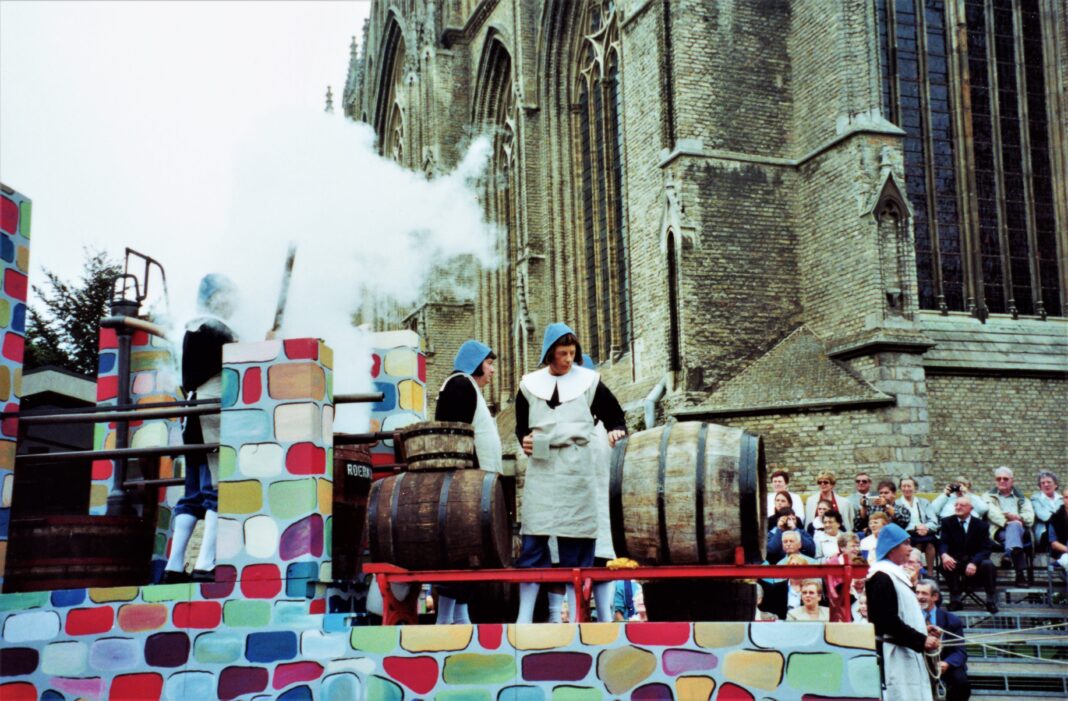
The central task today for your correspondent here at “Hip Hops” is to issue reminders about several forthcoming al fresco beer festivals, each fully worthy of your patronage.
Saturday, July 15: J-Town Summer Craft Beer Fest in Jeffersontown; Kevin Gibson has a stellar preview.
Saturday, July 29: Summer Beer Fest at Frazier, in front of the museum on Main Street.
Saturday, August 26: 2023 Brew at the Zoo with Wine and Food, Too!, at the Louisville Zoo (see WHAS-11 for a preview).
 Saturday, September 30: Steins on Main, a new Oktoberfest celebration to be held at RePurposed (615 W. Main Street), sponsored by Louisville Ale Trail, Louisville Downtown Partnership, and Against the Grain Brewery. The event supports the Coalition for the Homeless.
Saturday, September 30: Steins on Main, a new Oktoberfest celebration to be held at RePurposed (615 W. Main Street), sponsored by Louisville Ale Trail, Louisville Downtown Partnership, and Against the Grain Brewery. The event supports the Coalition for the Homeless.
Speaking of outdoor summertime beer events, here’s a story about the time when a VIP and an IBU walked into a beer fest, and the ABV turned to them and said, “SKU You Very Much.”
—
During the halcyon days of my misspent youth in Southern Indiana, when whiskey was blended (mostly with Coca Cola) and “craft” was the description of do-it-yourself mail order birdhouses, the arrival of summer invariably inspired a profusion of outdoor beer festivals.
So did fall, winter and spring.
When you’re 17 years of age, looking more like 12, forever ducking prying eyes and requiring divine intervention to get served at randomly obliging package stores, the great outdoors constantly beckoned as a place of refuge.
Priority was placed on those patches of isolated farmland belonging to folks who didn’t know or care that we’d found someone older to procure the cheapest swill possible, borrow a steel tub otherwise used to hydrate future beefsteak, buy bags of ice, and await the grapevine-laden onslaught of teenagers who’d learned there was a field party in progress.
When it rained, we got soaked; not the worst conceivable outcome in hot weather, especially if any of the girls bothered to come — which was very seldom.
But every now and then a fleeting measure of transcendence was achieved, and an enterprising reader might insert one of Bob Seger’s nostalgic AM radio hits to accompany this narrative, although I never cottoned much to his music after “Katmandu,” which I heard for the first time (where else?) at a summertime outdoor beer festival in the Knobs, with any style of beer you wanted available for thoughtful analysis so long as it was mainstream American lager, and with tunes like Seger’s blaring from the crackly subpar 8-track player attached to a car stuck axle-deep in a muddy field littered with cigarette butts and spent plastic cups.
Glorious times, indeed. A lifetime has passed, and nowadays the practice of lying about one’s age generally implies a bold downward revision of chronological information on Facebook. Falls City, once our cheap go-to old-fashioned lunch pail lager, went away, but then reappeared after an innovative craft-induced makeover.
Outdoor beer festivals have evolved considerably, too, bearing little resemblance to the midsummer’s night screams we staged during the presidency of Jimmy Carter — who, after all, legalized homebrewing at the federal level, but likely never experienced the welcoming nuzzle of a well-turned beer bong amid the steamy July drizzle.
The omission is so very sad.
—
Speaking of Seger, when I attended my first rock concert in 1975 at the age of 15, he wasn’t there at all.
The venue was Louisville Gardens and the band was Chicago, which at the time had made it to only IX of an eventual XXXVIII albums, and still leaned more toward rock than pop. Tickets were $6 in advance, and $7 “on day of show.”
38 years later in February of 2013 the remaining half-a-Who came to the Yum Center in Louisville to perform Quadrophenia. I’ve been to my share of concerts during the years since, but this one was especially important to me, seeing as the album being celebrated that night is among my all-time favorites of any genre.
Our tickets for Quadrophenia cost somewhere around $75 each after Ticketmaster’s various digital anal probes, and yes, these rates are a bargain compared to 2023 standards, but while purchasing these ducats in 2013 I noticed for the first time the option of upgrades, potantial embellishments that had previously eluded me.
By adding a paltry $1,500 to the bill, we could secure prime bragging rights position backstage as rock show VIPs.
Presumably we’d have been fed incredibly rare Black Sea caviar using a coke spoon formerly wielded by the late, great Keith Moon, then exchange pre-curtain pleasantries with Pete Townshend; after a spot of tea, he’d ceremonially smash a guitar atop my tonsure — no, wait, on second thought it was clearly stipulated that custom-impelled fretboard abuse aimed at my noggin would cost an added C-note or three, of which I naturally keep plenty around to light illicit Cuban cigars.
These VIP packages came as a shock, given purely spartan past experiences along the lines of “we suffered at Woodstock and so must you, too.”
In 1975, reserved rock concert seats were as rare as palatable American mass-market light beer is today, and festival seating was what you did after falling to the floor, sitting there dazed for a spell in a foredoomed effort to lasso your galloping buzz, and then (hopefully) rising again to your feet before missing any of the music.
Indeed, “seating” may have been a euphemism for “standing,” and yet an imperfect egalitarianism genuinely held sway. At least it seemed as if we were all in it together at a rock concert back then, as opposed to being rigorously egregated by wealth and status, a process fully customary in our everyday lives.
Being a 70s-era VIP meant waiting outside the venue for long hours in crotch-high snow drifts just like everyone else, until at last the doors opened. Maybe a guitar pick or drum stick came flying your way later during the performance, but bidding in advance for preferential goodies simply didn’t exist; official programs and concert tees were available in the lobby at market rates for rich and poor alike, assuming they carried hard cash.
However, hearing loss and delirium tremens aside, I’ve no interest in debating the shifting sands of multinational musical economics.
Rather, I’m wondering how long it will take before VIP packages at today’s craft beer festivals begin reaching the rarified heights of like-minded options at musical performances, providing greater exclusivity for purchasers in the form of selected access and curated perks for those with the bucks to buy their way into the less-populated compound.
If we’re not careful, attending a beer fest might soon cost as much as buying a bottle of Road-Kill-PA by BrewDog, while those unable to afford the tickets will be compelled to make do with MadDog 2020 (albeit newly “crafted” with free range formaldehyde).
A tad harsh, maybe; vive la différence and all that. To be honest, these VIP-related thoughts first occurred to me a long time ago, during a period of extreme festival burnout (ask any brewery employee, past or present, to explain).
Since then I’ve mellowed considerably and wouldn’t say “Taco Bell” if I had a mouthful. But why waste a quality polemic?
—
Nowadays I attend few live musical events, and even fewer outdoor summertime beer fests. Too many of the former are marred by the prevailing skullduggery of audio gimmicks and backing tracks, while the latter inevitably unspool in the sultry open air amid the least comfortable weather conditions of the year — and I perspired quite enough playing basketball in high school, thank you.
Speaking candidly, I’d rather listen to the original rock albums with headphones, nursing selected “better” beers; sorry Silver Bullet (Coors, not Band), you’re emphatically NOT invited to my listening party, preferably situated in a climate-controlled space, reclining in my tattered armchair, and within easy stumbling distance of a peaceful, non-claustrophobic toilet.
The availability of a microwave oven and leftover Chinese carryout food is a plus, but not entirely necessary. A can of Vienna sausages and stale Saltines will do in a pinch, which is why they still have an important place in everyone’s emergency pantry.
If my memory is to be trusted, it was ten years ago during the Quadrophenia year, while I was serving on the board of the Brewers of Indiana Guild, that VIP ticket packages appeared for the first time as attendee options for BIG’s annual Microbrewers Festival in Indianapolis.
In retrospect, the guild was coming rather late in the game to contemporary ticket-pricing strategies. Still, I didn’t like it the idea at all. My first reaction to the inclusion of a BIG fest “VIP Experience” entry tier was to wonder aloud whether it also included time with Three Floyds’ house tattoo artist.
Would vestal virgins from the soybean belt be present to hand-stitch hop pillows?
Could we schedule a keynote speech to the VIP contingent by the late Michael “Beer Hunter” Jackson, via a contrived séance with accompanying snazzy hologram?
And let’s not forget the silver trays with pork belly pâté prepared after slaughtering a hog raised entirely on spent grain culled from Goose Island Bourbon County Stout (the reputed aphrodisiac effect on its devotees can be brutally satirized another day).
Back in 2013 I was speedily and decisively outvoted. My peers did not share my point of view, and VIP packages became a popular (and remunerative) feature of future BIG fests. I’ll readily concede that in 2023, considerations of what the mature craft beer market will bear in this specific context of fests and public gatherings is no longer particularly relevant, even to me.
It seems that rear-guard minority positions are a specialized skill of mine. Who’d have guessed? Harrumph.
When it comes to business, one’s conscience is infinitely mutable, not excluding my own, and the VIP stallion galloped merrily out of the neglected festival barn door so long ago that the only remaining question has to do with the pros and cons of one’s chosen method of payment: credit card, PayPal, or gold doubloons.
Consequently, it’s time for me to climb down from my high horse and note that VIP tickets for the approbation of the beer’s über-enthusiasts (or the trend-hopping hangers-on, or the multi-national brewing execs seeking the next big thing to utterly ruin) no longer strike me as illegal, immoral or fattening.
But I’ll continue to argue that beer festival planners should strive always to improve the quality of the overall experience for the sweaty throngs who pay general admission, even as they rightfully accept VIP funding as dollops of icing on the cake.
In aggregate, general admission beer festival ducats still comprise the bread and butter for the fest’s fiscal statement, so let’s hope the commoners needn’t be subjected to the mud, blood and leftover flagship beers alone, at the risk of becoming embittered by VIP privileges, left to pine for their own ration of Imperial Beer Geek Brunch Civet Stout as the VIPs strut the corduroyed catwalk, pinkies extended, constantly checking their iPhones to make sure the beer they’re drinking is the truly rare Rye Barrel release, and not the hoi poloi’s MGP bourbon barrel version that anyone can buy (and subsequently hoard).
I will as yet maintain that when it comes to beer festivals, it’s the general admission attendees who are far more likely to embrace and evangelize better beer, helping our segment reach the next percentile by broadening the exposure, bringing more discerning beer drinkers into the tent, and perpetuating the egalitarianism that should be the foundation of the beer revolution.
Let’s not forget it, okay? In return, I’ll readily concede that VIPs absolutely have their proper place when it comes time to calculate the bottom line. However, as John Frank writes at Axios, all these consideratons might well be in vain, because “the death of the beer festival is jolting the craft brewing industry.”
Paging Mr. Townshend, Mr. Peter Townshend — say old boy, if you’re not using that axe, might I borrow it for just a moment or two? After all, I have some important “advocating” to do.



















 Roger Baylor is an entrepreneur, educator, and innovator with 41 years of beer business experience in metropolitan Louisville as a bartender, package store clerk, brewery owner, restaurateur, writer, traveler, polemicist, homebrewing club founder, tour operator and all-purpose contrarian.
Roger Baylor is an entrepreneur, educator, and innovator with 41 years of beer business experience in metropolitan Louisville as a bartender, package store clerk, brewery owner, restaurateur, writer, traveler, polemicist, homebrewing club founder, tour operator and all-purpose contrarian.


